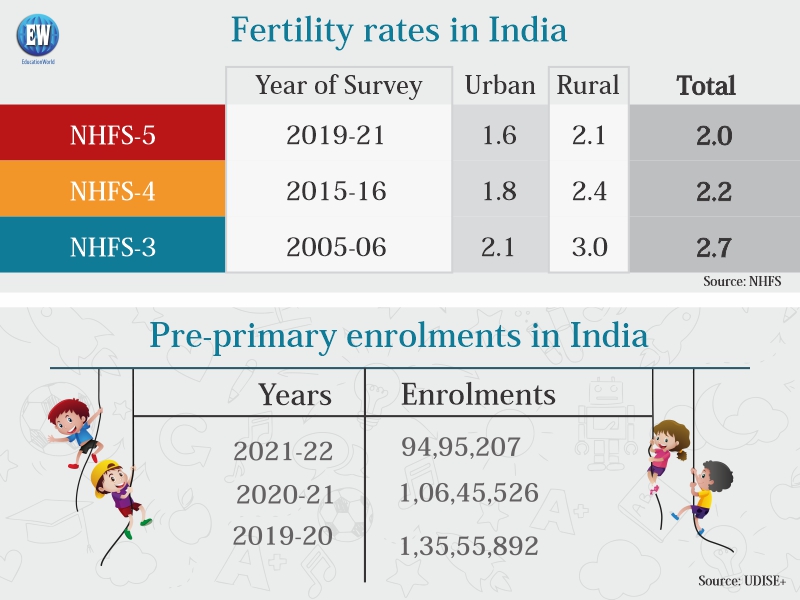Reshma Ravishanker
There has been a significant, 40.60 lakh dip in admissions into pre-primaries in just three years in India, a recent survey has indicated. A gradual fall in fertility rates, the pandemic and underreporting are among primary reasons, experts believe.
As against 1.35 crore enrollments reported in the 2019-20 report, the number of students who got admitted into pre-primaries as reported in the 2021-22 report is a mere 94,95,207. The Unified District Information System for Education Plus report indicates the numbers were 1.06 lakh in 2020-21.
Experts in the field of education believe that it could partly be induced by the pandemic, that resulted in migration and discontinuation of education while another aspect was also the reduced number of children eligible to go to schools because of declined fertility rates.
To put it into perspective, according to the National Health and Family Survey (NHFS), the fertility rates (number of children a woman has in a lifetime) saw a dip. NHFS 3 (2005-06) reported a fertility rate of 2.7 in India, which declined to 2.2 in NHFS- 4 (2015-15) and further to 2 as per NHFS 5 (2019-21).
Dr AS Seetharamu, former professor of education, Institute of Social & Economic Change, Bengaluru believes that population decline is a significant factor. “There is a reduction in newborns and hence lesser are the number of school going children. It has been predicted that total population in India will see a negative trend by 2030. By 2040, a steep fall in child population is foreseen. There is going to be under utilization of resources and infrastructure and surplus facilities by 2045.
“This has happened in many European countries in the past. Australia for instance, gave extra incentives to couples having a third child. Somewhere down the line, India could come to that. Even China, having seen a downward fertility rate has revised its one child policy,” he explained.
Besides, Seetharamu said that a margin of grace must be given to this as the data was collected during the pandemic. “The data collection happened during pandemic and could be under reported. Families migrated, left schools and were indecisive about education, that could have caused reduction in numbers.
Meanwhile, Gurumurthy Kasinathan, Bengaluru-based director of IT For Change, an NGO believes that this could be attributed to the country’s economic situation. “With a lack of jobs, there is not money for couples to spend on. This means they will have fewer children or not send all to school. Decreased fertility rate is certainly a factor. Some states like Tamil Nadu have a negative growth rate. However, the reasons in larger states like Uttar Pradesh and Bihar is bound to be different. Pandemic related migration or dropouts must be considered,” he said.
Dr Asha Benakappa, head of the Department, Pediatrics, Dr Chandramma Dayananda Sagar Institute of Medical Education and Research agrees that a decrease in birth rates is a possible factor for drop in number of children seeking admissions. “This could be co-relatable. In the recent past, the country is witnessing fertility challenges among couples. Factors include stress, insulin resistance, postponement of marriage or conception itself. There is a boom in fertility clinics as well,” she said.
